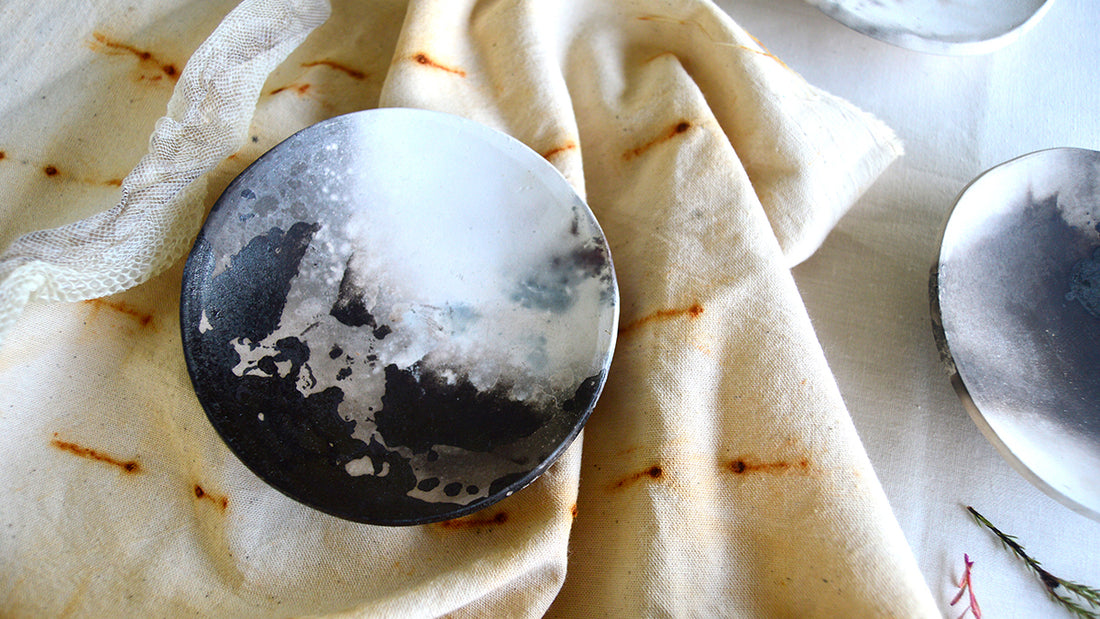I experimented with rust dyeing a few years ago and came away with some beautifully transformed pieces of fabric. I use these to bring texture and colour into the photos of my ceramics, and because they're so striking I'm always asked how/where/what about the material or the process.

I love DIY and sharing what I know- so, here is a little how-to for you to try rust dyeing for yourself!
The approach I took to my rust dyeing experiment is adapted from different tutorials that I found online. Most, if not all, require you to use vinegar to transfer the rust from your metal objects onto your fabric.
I tried the vinegar technique for myself and found that it wasn’t as effective as I’d hoped, so I tried something a little different. We know that metal + water + oxygen = rust, and adding salt to that mix accelerates the rusting process. So my magical rust dyeing solution is plain old salty water.

*Note: I'm a little aggressive with fabric here and pierce through it with the nails so I can keep dunking it into the salty water over the days. You might want to try a different approach where you lay rusty/rustable items onto your fabric and spray or splash the salty water on instead.
You’ll need:

I love DIY and sharing what I know- so, here is a little how-to for you to try rust dyeing for yourself!
The approach I took to my rust dyeing experiment is adapted from different tutorials that I found online. Most, if not all, require you to use vinegar to transfer the rust from your metal objects onto your fabric.
I tried the vinegar technique for myself and found that it wasn’t as effective as I’d hoped, so I tried something a little different. We know that metal + water + oxygen = rust, and adding salt to that mix accelerates the rusting process. So my magical rust dyeing solution is plain old salty water.

*Note: I'm a little aggressive with fabric here and pierce through it with the nails so I can keep dunking it into the salty water over the days. You might want to try a different approach where you lay rusty/rustable items onto your fabric and spray or splash the salty water on instead.
You’ll need:
- Fabric to dye (I used some vintage lacy-edged fabric & different pieces of calico)
- Rusty items (not everything needs to already be rusty- cheap sewing pins, office pins and staples can all be used new and will rust on the fabric when in contact with the salt water)
- A bucket
- Salt (any kind is fine, you don’t need to use fancy sea salt)
- Water
- A plastic tray, or plastic bags
1. Attach the rusty/soon-to-be-rusty items to your fabric

Pierce nails and sewing pins through, go wild with a stapler. You can create a pattern if you're keen or go for a more random finish. Up to you.
If you want to lay them items on top of your fabric instead make sure you do this on some form of plastic tray. That way if you need to move your fabric before the process is over the arrangement won't be disturbed.
2. Mix up a bucket of salty water
Just enough to saturate your fabric. Or you can mix up more and keep it aside for the whole process.
3. Get your fabric wet and salty


Plunge the fabric into the salty water to fully saturate it. Take it out the water and spread it out on a plastic tray or plastic covered surface and leave it to sit in the excess water.
Oxidation will soon set in, and you'll start seeing rusty imprints form on the fabric.
4. Keep at it, and keep it moist


As you notice the fabric drying out, spray or gently splash more salty water onto it to keep the process going. The longer you leave the fabric in contact with the rusty objects the deeper the colour that will develop. I did my rust dyeing over 10 or so days.
5. Dry and set


Once you're happy with the intensity of the rust colour, let the fabric dry and remove the rusty objects. Give it a good rinse in fresh, not salty, water, and leave to dry again. Once the fabric is dry the final step is to iron the finished piece. It is now ready to use!


I love the unpredictable nature of rust dyeing- it's a bit like saggar firing in that sense. You can control it to a certain extent, but part of the joy is letting go of knowing the outcome.
It's an environmentally-friendly process that requires no harmful chemicals, and you can lean into that sustainability by using vintage fabric or fabric that you already own to create your rusty textiles.
It's an environmentally-friendly process that requires no harmful chemicals, and you can lean into that sustainability by using vintage fabric or fabric that you already own to create your rusty textiles.
Are you gonna try some rust dyeing? Let me know, because I'd love to see your results!

